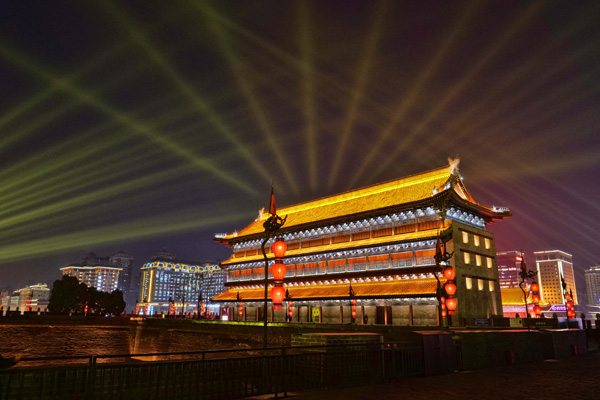
by successfulbob | cityscape photography, Guest Post, landscape photography, Lumix G85, travel photography
Travel in China – Xi’an
Guest Post – Ken MacAdams
Ken has been traveling in China and settling in for long periods. His last visit was for quite a while in Xi’an. Enjoy his images and commentary.
“I’ve been in Xi’an for nearly two months now. Living like a local has great rewards. In my apartment complex, I play on the jungle gym with the little kids (who come running and squealing to me – babbling away in Chinese that I can’t understand) when they spot me walking by! I go to the local street market to purchase my fruits and vegetables with my neighbors. I ride the bus with university students, businessmen and secretaries going about their daily lives. And nothing is more rewarding than the toothless old granny who bursts into a smile when I say “Neho” (hello) as we pass on the street!
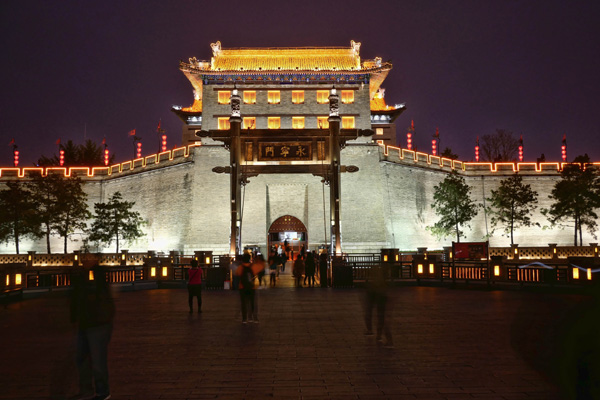 The drawbridge over the moat with the archers tower behind.
The drawbridge over the moat with the archers tower behind.
This wall is the only ancient city wall completely intact in China. This is one of the archers towers over the drawbridge. Besides longbows, they had crossbows capable of reaching 1/4 of a mile. It would have been deadly to try to gain entrance uninvited!
This is one of the archers towers over the drawbridge. Besides longbows, they had crossbows capable of reaching 1/4 of a mile. It would have been deadly to try to gain entrance uninvited!
The lights at nighttime are magic!
As a tall Westerner, I stand out, but I find the Chinese people very warm and welcoming, even if there is a huge language barrier! The “translator” app on my phone gets a daily workout, but many of the younger folks have studied some English, and although bashful about using it, they’ll often come to my rescue!
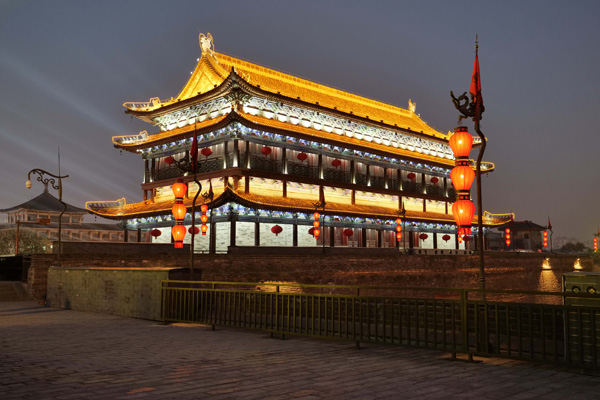 This is a temple on the ancient wall.
This is a temple on the ancient wall.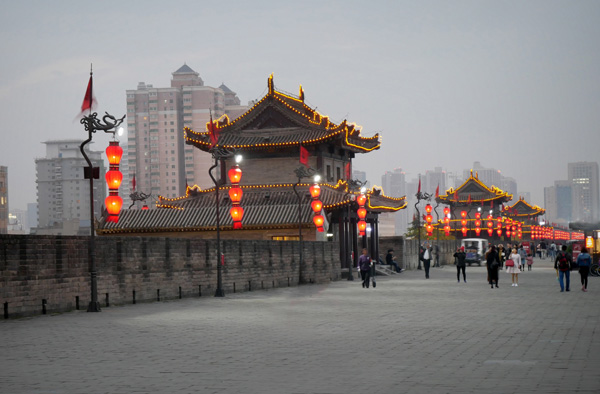 Guard towers stationed along the top of the wall. Note the smog in the atmosphere.
Guard towers stationed along the top of the wall. Note the smog in the atmosphere.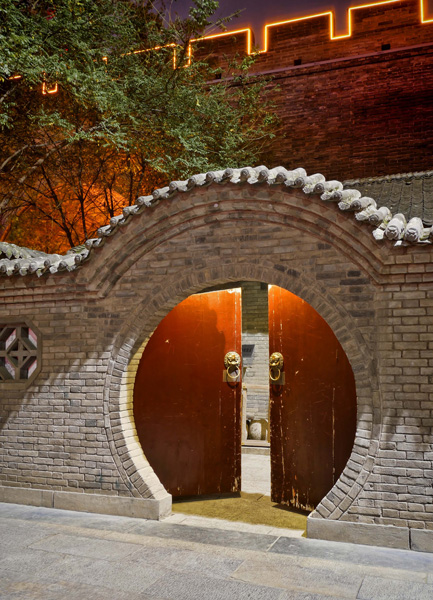 Entrance way along the wall.
Entrance way along the wall. Although I concentrate most of my time in Xian, I travel out to photograph in provinces to the east and west. China continues to expand routes serviced by their high speed “bullet” train, the futuristic aerodynamic trains that travels at 200 MPH. Travel between major cities is quick, quiet, and competitive with air travel. To me, traveling on the train, is just part of “living like a local.”
More from Ken and Xi’an, China Next Friday!
Ken has always loved to travel, so when he made a common connection with the fact that either a long day pounding the streets of some foreign city, or shooting the last dance at a wedding, a good part of his physical

weariness came from lugging around his big heavy DSLR. That’s when he started looking at alternatives – and ended up selecting Panasonic Lumix Micro Four Thirds gear.
Ken is rarely without a camera, and the next great photo travel experience – whether local or abroad – is always in the back of his mind! A longtime resident of the Four Corners, and when he’s not out on the road, he enjoys some of the great outdoor opportunities found there – mountain biking, hiking, and Jeeping.
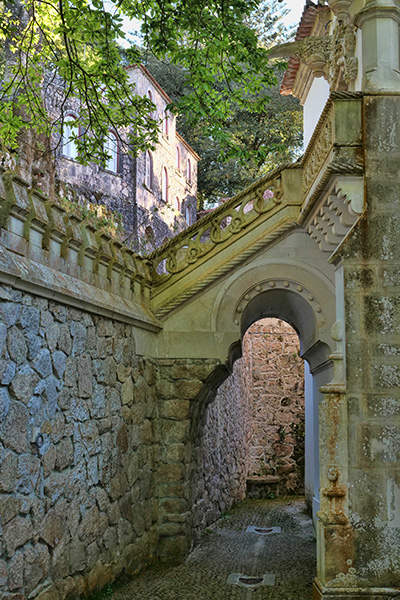
by successfulbob | cityscape photography, Guest Post, Lumix G9, travel photography
Sintra, Portugal – Guest Post Part Two
by Ken MacAdams
Ken shares his travel photography and stories here on Successful-Photographer as he has in the past. Ken’s camera of choice is Panasonic’s flagship stills camera the Lumix G9 with the Leica DG Vario-ELMARIT Professional Lens, 12-60MM, F2.8-4.0
Take it away Ken. Start with part one of this story here.
A five minute walk downhill brought me to my second stop, the Moorish Castle. The castle was constructed during the 8th and 9th centuries, during the period of Muslim Iberia. The castle was centrally located in an area that was primarily agricultural, and was necessary for protection of the residents. It was a strategic point during the Reconquista, but was taken by Christian forces after the fall of Lisbon in 1147. Settlers occupied the castle during the 12th and 13th centuries, but its military importance was progressively diminishing, and inhabitants were abandoning the castle for the old village of Sintra. In the beginning of the 15th century a small group of Jews occupied the castle until being expelled from the country by Manuel I of Portugal.
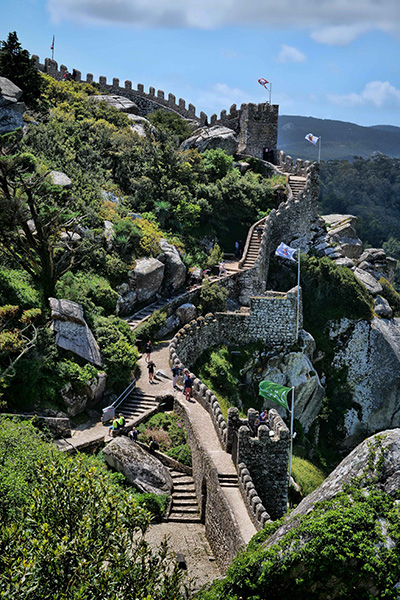
Inside the Moorish Castle. These walls match the terrains ups and downs with lots of archery vantage points. In ancient days, they would have cleared the trees around the outside of the compound so attackers had no shelter. Images in this post © Ken MacAdams
The 1755 Lisbon earthquake caused considerable damage to the chapel and castle. It wasn’t until King Ferdinand II began work on the Pena Palace around 1840, that he took up the task of improving the condition of the old Moorish Castle and walls. The castle is built on very rugged terrain with slopes reaching 40% gradients. The hike around the castle walls is bound to elevate your pulse! A stop at each watchtower allows you to catch your breath and enjoy the magnificent views.

Secluded archway leading to the palace. Examine the rope detail on the sides of the stairs.
Having navigated the castle walls, I retraced my steps – also uphill – to where I’d parked the car. Returning to back to Sintra, I visited the Quinta da Regaleria. This highly decorated, ornate Gothic styled, multi-story 20th century residence is situated in Old Town. The original house dates back to the 1800’s. Over the years, subsequent owners have made renovation, the most recent being about 1904, when carved gargoyles, Gothic turrets, exotic woodwork and other ornate features were added. Additions by an Italian architect evoked Roman, Gothic, Renaissance, and Manueline styles. Located within the park is the palace and chapel, and a luxurious park with walkways, lakes, grottoes, wells, benches, statues, and fountains.
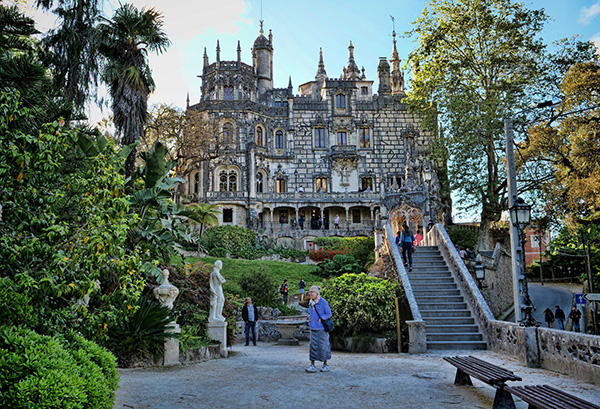
The Quinta da Regaleria palace and stature gardens.
The true wonder of the Quinta da Regaleria are the grounds, which were inspired by the owner’s mystic ideologies. Hidden within the grounds are references to the Knights Templar, the Masons, and dark alchemy. The well, one of the strangest features, has a concealed circular passageway that descends 88 ft. downward, then connects to a series of tunnels that run the length of the garden. The well symbolizes the initiation ceremony for the Knights Templar. As you walk through the gardens, you’re also awarded occasional glimpses of the Moorish Castle and Pena Palace high up on the mountain above you.
I’d packed all three sights into one day, so my feet were happy to settle into a comfy booth at one of downtown Sintra’s cafes! Shortly thereafter, I returned to the villa, and enjoyed a quiet nights’ sleep.
Ken has always loved to travel, so when he made a common connection with the fact that either a long day pounding the streets of some foreign city, or shooting the last dance at a wedding, a good part of his physical

weariness came from lugging around his big heavy DSLR. That’s when he started looking at alternatives – and ended up selecting Panasonic Lumix Micro Four Thirds gear.
Ken is rarely without a camera, and the next great photo travel experience – whether local or abroad – is always in the back of his mind! A longtime resident of the Four Corners, and when he’s not out on the road, he enjoys some of the great outdoor opportunities found there – mountain biking, hiking, and Jeeping.
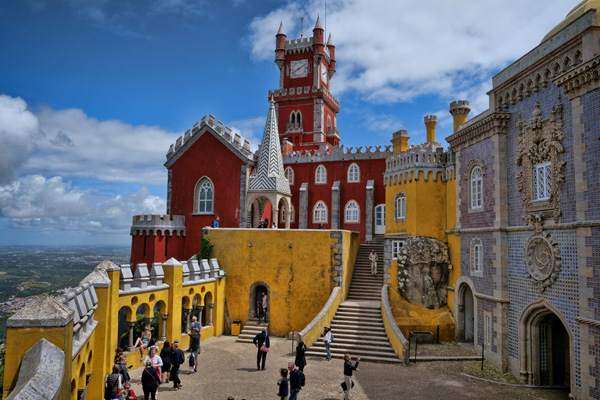
by successfulbob | architectural photography, cityscape photography, Guest Post, photography, travel photography
Sintra, Portugal – Guest Post
by Ken MacAdams
Ken is a traveling man and uses Lumix gear during his travels. Ken shares his travel photography and stories here on Successful-Photographer as he has in the past. Ken’s camera of choice is Panasonic’s flagship stills camera the Lumix G9 with the Leica DG Vario-ELMARIT Professional Lens, 12-60MM, F2.8-4.0
Take it away Ken
Situated 30 miles from Lisbon is a fairy-tale village named Sintra. Driving up from Lisbon on heavily forested, narrow and very twisty roads, I was shocked when the vibrantly colored Pena Place burst into view! I continued on to the quaint town of Sintra, where I’d reserved a villa, nestled in the cliffs, hundreds of feet below the palace. I was told the villa was once the king’s stables.
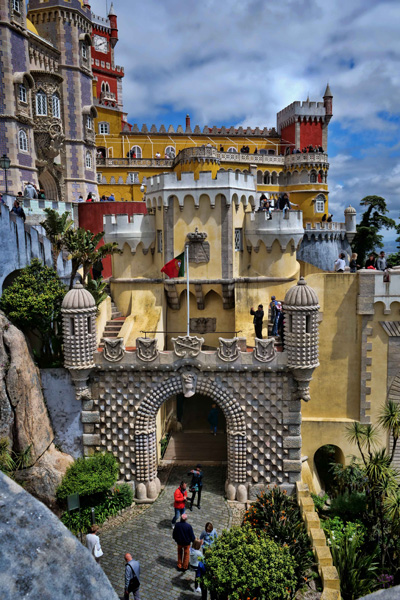 Entrance to the Pena Palace. Built around the craggy rocks of the mountaintop, the palace has a commanding view of the surrounding area. All Photos in this post © Ken MacAdams
Entrance to the Pena Palace. Built around the craggy rocks of the mountaintop, the palace has a commanding view of the surrounding area. All Photos in this post © Ken MacAdams
After a sumptious breakfast, I joined the parade of cars snaking up the mountainside to my first stop, the Palace of Pena. Situated atop a rocky peak, the palace has a commanding view of the surrounding valleys.

The rear of the palace, with views stretching all the way to the North Atlantic Ocean, on the horizon.
In 1838 King Ferdinand II acquired the former Hieronymite monastery of Our Lady of Pena. The original monastery buildings, consisting of the cloister and outbuildings, the chapel, the sacristy and the bell tower, were built in 1511. These buildings today form the northern section of the Palace of Pena, and are referred to as the Old Palace. King Ferdinand began making much needed repairs to the former monastery, and replaced the fourteen cells used by the monks with larger rooms with vaulted ceilings. About 1843 the King decided to enlarge the palace, and built a new wing with even larger rooms. This section is known as the New Palace.
In transforming the former monastery, the King was likely influenced and inspired by German romanticism found in the castles along the Rhine. When building on the New Palace was completed about 1865, the King began planting gardens surrounding the palace. With winding paths, stone benches, and pavilions at different points along its routes, the King copied the romantic gardens of that time. He also planted over 500 different species of trees, and plants originating from different points around the globe.
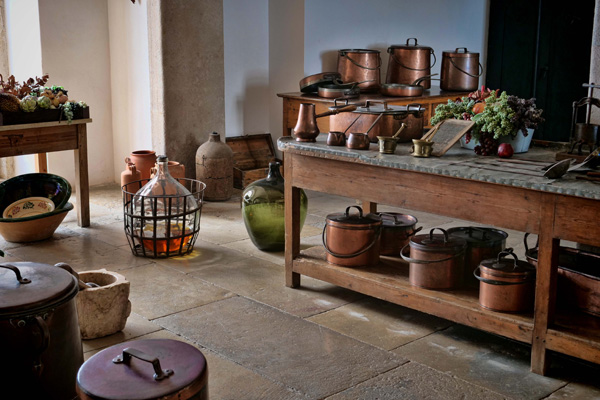
The one way tour circuit through the palace is self paced, generally ambling along at a relaxed speed. You see both the Old and New Palace wings, visit the living quarters of the King, their eating area, day rooms, the Great Room, and end up exiting through the kitchen. With original and period glassware, pottery, and furniture throughout the palace, you’ll have a chance to see how life was carried on by royalty of the 1800’s! The Palace of Pena was designated a National Monument in 1910, and classified a UNESCO World Heritage site in 1995.
Ken has always loved to travel, so when he made a common connection with the fact that either a long day pounding the streets of some foreign city, or shooting the last dance at a wedding, a good part of his physical

weariness came from lugging around his big heavy DSLR. That’s when he started looking at alternatives – and ended up selecting Panasonic Lumix Micro Four Thirds gear.
Ken is rarely without a camera, and the next great photo travel experience – whether local or abroad – is always in the back of his mind! A longtime resident of the Four Corners, and when he’s not out on the road, he enjoys some of the great outdoor opportunities found there – mountain biking, hiking, and Jeeping.
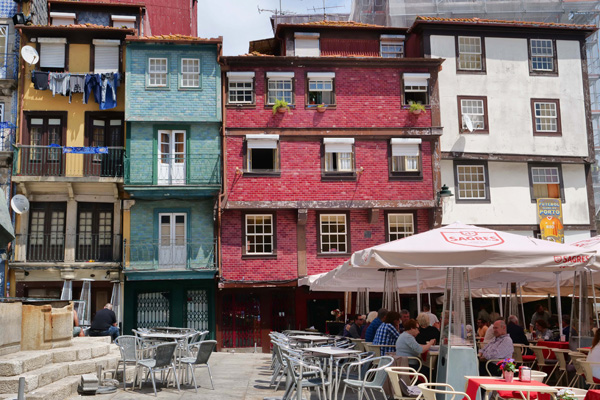
by successfulbob | cityscape photography, Guest Post, Lumix G9, travel photography
Porto, Portugal – Guest Post
by Ken MacAdams
Ken is a traveling man and uses Lumix gear during his travels. Ken will share some of his travel photography and stories here on Successful-Photographer as he has in the past. Ken’s camera of choice is Panasonic’s flagship stills camera the Lumix G9 with the Leica DG Vario-ELMARIT Professional Lens, 12-60MM, F2.8-4.0
Heeeeere’s Ken!
Porto is a coastal city in northwest Portugal known for its port wine and stately bridges. In the medieval riverside Ribeira district, narrow, hilly cobbled streets wind past merchants’ cafes and houses. Close by is the Dom Luis I Bridge, a double deck metal arch bridge that was designed by Gustav Eiffel, the same man who designed Paris’ famous Eiffel Tower. Spanning the River Douro between the cities of Porto and Vila Nova de Gaia, this unique bridge offers great views of the river and city. You can walk across either level of the bridge, but most of the activity takes place on the streets adjoining the lower level, or riverside.
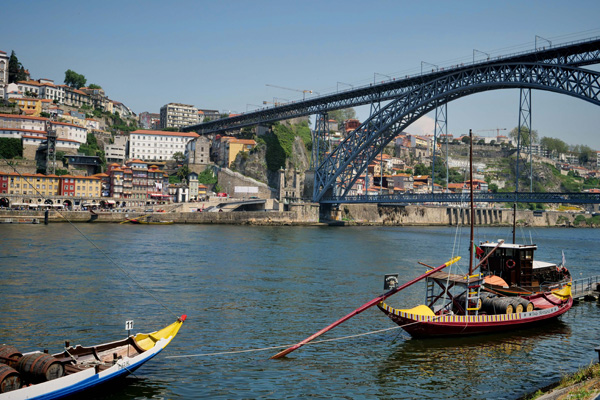 Dom Luis I Bridge. The bridge was designed by Gustav Eiffel. Rabelo boats in the foreground.
Dom Luis I Bridge. The bridge was designed by Gustav Eiffel. Rabelo boats in the foreground.
All Photos in this post © 2019 Ken MacAdams
While on the Vila Nova de Gaia city side, or south side of the river, we turned down Avenida Diogo Leite, a street paralleling the River Douro. This street is lined with a multitude of sidewalk cafes, and numerous wine tasting establishments. Settling in at one of the sidewalk cafes, we enjoyed the views of watercraft plying the River Douro, with the hillside city of Porto in the background.

Cafes and housing in the old Riberia district, Porto.
While history tells us it was the Romans – early conquerors of this land – that introduced the first grapevines to this area, it was the Brits who championed port. The significance of the wine producing Douro area dates back hundreds of years. When England was at war with France in the early 1700’s, English merchants began importing wine from this region, for the deprived English wine drinkers of French wines. British importers realized the need for a smooth fortified wine that would not only appeal to English palates but would also survive the trip to London.
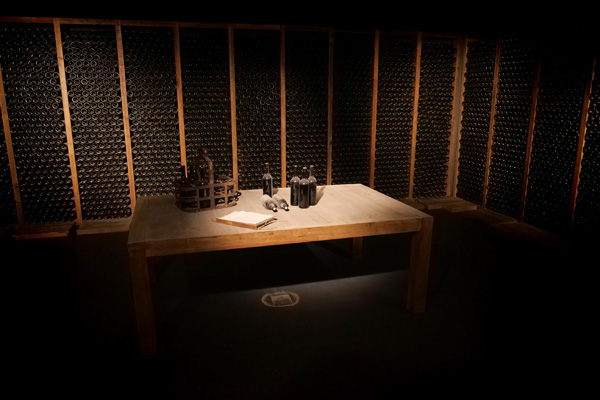
Wine Cellar
Port wine is typically richer, sweeter, and higher in alcohol content than unfortified wines. This is caused by the addition of distilled grape spirits to fortify the wine and halt fermentation before all the sugar is converted to alcohol, and results in a wine that is usually 19% to 20% alcohol. The grapes aren’t grown in Porto itself, but in the region extending inland up the Douro River Valley.
To be continued next Friday. Porto, Portugal – Part Two
 Ken MacAdams – “I grew up with a darkroom in my basement…so all the old film skills were my friend when digital came on the scene. Funny thing happened…photography just got more interesting as digital posed new challenges! While I loved the characteristic sounds and smells of the old wet-process darkroom days, I wouldn’t go back!”
Ken MacAdams – “I grew up with a darkroom in my basement…so all the old film skills were my friend when digital came on the scene. Funny thing happened…photography just got more interesting as digital posed new challenges! While I loved the characteristic sounds and smells of the old wet-process darkroom days, I wouldn’t go back!”
Ken has always loved to travel, so when he made a common connection with the fact that either a long day pounding the streets of some foreign city, or shooting the last dance at a wedding, a good part of his physical weariness came from lugging around my big heavy DSLR. That’s when he started looking at alternatives – and ended up selecting Panasonic Lumix Micro Four Thirds gear.
Ken is rarely without a camera, and the next great photo travel experience – whether local or abroad – is always in the back of his mind! A longtime resident of the Four Corners, and when he’s not out on the road, he enjoys some of the great outdoor opportunities found here – mountain biking, hiking, and Jeeping.

by successfulbob | cityscape photography, landscape photography, panorama, photography, photography competition
Professional Photographers of America
Southwest District Competition – Photographic Open Results
Professional Photographers of America supports photographic education in many ways. One of those is through the Merit and Degree program. Two of the degrees are image based on that you need to earn thirteen Merits plus another twelve Merits for service or education in the industry.
On the way to International Photographic Competition (IPC) is a proving ground called the Districts. The country is divided into five different Districts of which I am a member of the Southwest District. They recently completed the judging, and I earned Merits for all eight of my entries. Additionally, I received an automatic Loan Collection image for scoring 95 or above. Another image will be judged for Loan when IPC commences August 5th through 8th at Gwinett Technical School just outside Atlanta in Georgia.
I’ll share my images here except for one that will be judged for Loan Collection as the judges are not to have access to any unjuged photos.
 ‘Days End’ – A spectacular sunset on the red rocks in Sedona viewed from Hwy 179.
‘Days End’ – A spectacular sunset on the red rocks in Sedona viewed from Hwy 179.
A slightly different version of this image is available for sale through the Gallery of Modern Masters in the Hillside Shopping area. Day’s End will be automatically accepted into the PPA Loan Collection at the final judging in August because it scored above a 95.
 A capture of my Muse Pash Galbavy who is an incredible artist who is in love with nature. She is a life model, mask maker, performance artist and so much more. Other images from this series with Pash are also available through Gallery of Modern Masters. This image earned a Merit score
A capture of my Muse Pash Galbavy who is an incredible artist who is in love with nature. She is a life model, mask maker, performance artist and so much more. Other images from this series with Pash are also available through Gallery of Modern Masters. This image earned a Merit score
 While in Nashville at last year’s PPA convention I hoofed it out to the bridge to capture a night shot of the skyline along the river. This image also earned a Merit score.
While in Nashville at last year’s PPA convention I hoofed it out to the bridge to capture a night shot of the skyline along the river. This image also earned a Merit score.
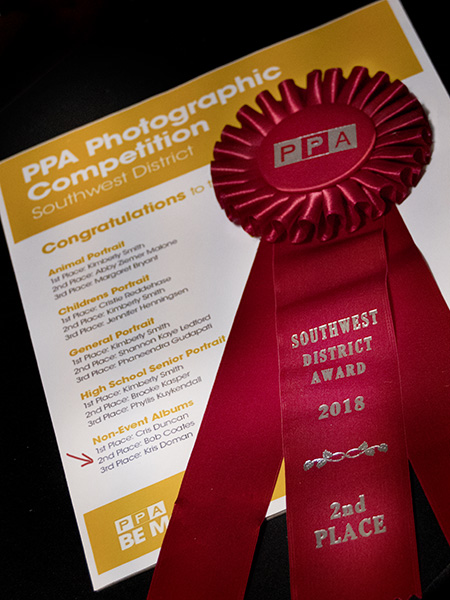 This image will represent the Non-Event album which scored a 92. I can’t share the images from this until after judging for the Loan Collection in August. It scored second place in the category.
This image will represent the Non-Event album which scored a 92. I can’t share the images from this until after judging for the Loan Collection in August. It scored second place in the category.
These are the Photographic Open Category images. In the next couple days, I’ll share my Artist entries with you.
Yours in Creative Photography, Bob

by successfulbob | cityscape photography, Lumix G9, photography education, photography gear
Skyline of Columbus Ohio
I was off teaching outside of Columbus, Ohio in Dublin this past weekend. These days when I travel for business, I try to schedule some time for doing some photography on either side of the event. Weather doesn’t always work out for the best as plans are made in advance! But you take what you can get.
I was planning on photographing the Columbus skyline from the bridge at night with the river reflection. There were recent floods which left the banks mud-stained, the wind was blowing about twenty mph and, the skies were less than desirable. Other than that it was excellent! ; )>
The nasty weather didn’t stop me from making a few images from the area. I got to the Main Street Bridge and did the best I could. I’m still testing the Lumix G9 and its 80MP capabilities, and it impresses me.
 This is a panoramic crop from an 80MP file. After cropping, the photo is ~ ten inches by thirty-six inches at 300dpi. A file size I could print to approximately seventy inches wide with no problem.
This is a panoramic crop from an 80MP file. After cropping, the photo is ~ ten inches by thirty-six inches at 300dpi. A file size I could print to approximately seventy inches wide with no problem.
Lens 12x60mm Leica f2.8-4.0
 This is a tiny section of the skyline cropped to give you an idea of the detail.
This is a tiny section of the skyline cropped to give you an idea of the detail.
I thought it might be fun to try and get the bridge in the foreground with the city in the background through the supports.
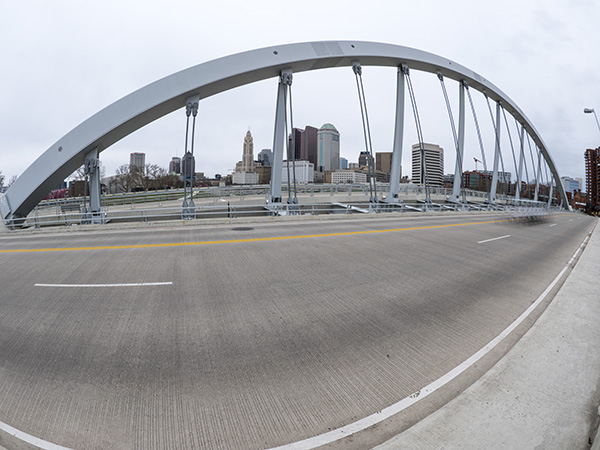 This was made using the 8mm f3.5 fisheye lens.
This was made using the 8mm f3.5 fisheye lens.
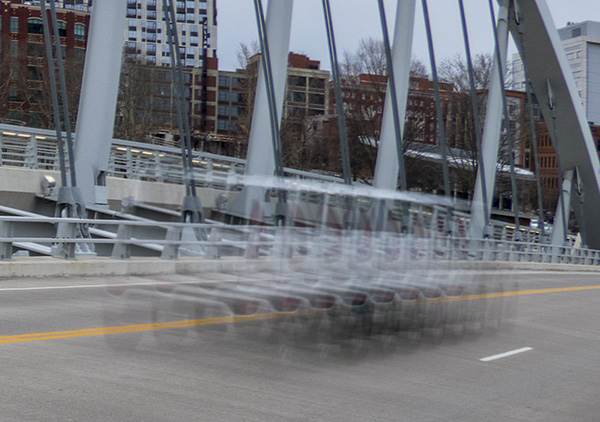 Crop section of moving car. The repetition is due to the multiple captures being made to create the 80MP file.
Crop section of moving car. The repetition is due to the multiple captures being made to create the 80MP file.
This image shows that capturing a moving subject during the exposure is not such a great idea. Or is it? I’m thinking about some creative possibilities in making a scene be devoid of people. Or just giving the hint of people in a scene. What about water photographed with a slow shutter speed?
I’ll be playing (er I mean working with) this large MP capture feature and let you know how it works out. If you’ve got any thoughts, ideas or examples of your testing, this feature, let me know.
Yours in Creative Photography, Bob

 The drawbridge over the moat with the archers tower behind.
The drawbridge over the moat with the archers tower behind. This is one of the archers towers over the drawbridge. Besides longbows, they had crossbows capable of reaching 1/4 of a mile. It would have been deadly to try to gain entrance uninvited!
This is one of the archers towers over the drawbridge. Besides longbows, they had crossbows capable of reaching 1/4 of a mile. It would have been deadly to try to gain entrance uninvited! weariness came from lugging around his big heavy DSLR. That’s when he started looking at alternatives – and ended up selecting Panasonic Lumix Micro Four Thirds gear.
weariness came from lugging around his big heavy DSLR. That’s when he started looking at alternatives – and ended up selecting Panasonic Lumix Micro Four Thirds gear.

























